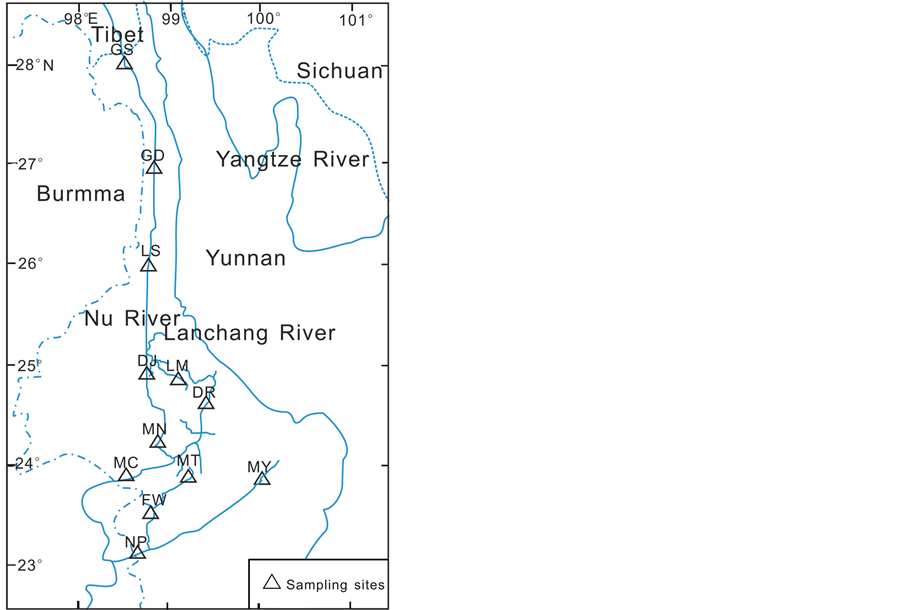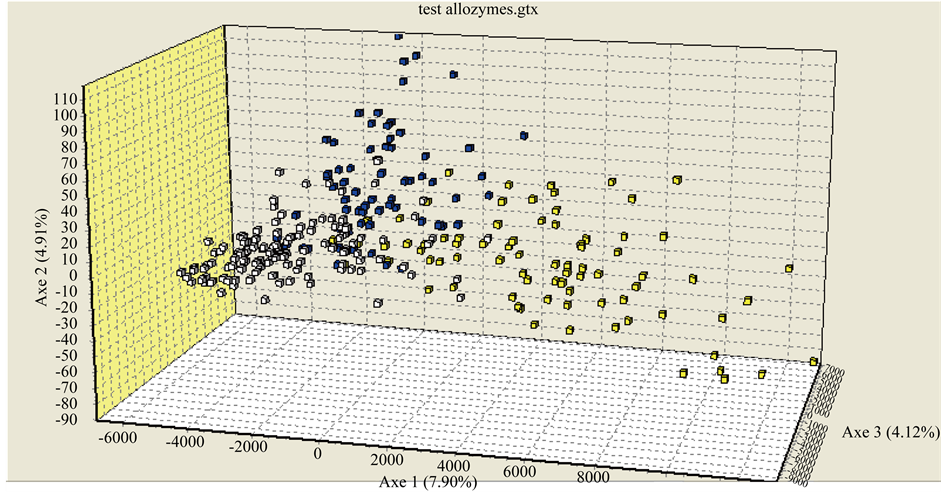Agricultural Sciences
Vol.5 No.6(2014), Article ID:45925,8 pages DOI:10.4236/as.2014.56050
Strong Genetic Differentiation of Glytothorax zanaensis (Wu et al. 1981) in Nu River, China
Xiping Yuan1,2, Dengqiang Wang2, Shaoping Liu2, Hong Li1, Wang Ke2, Xinbin Duan2, Daqing Chen2*
1Fishery Research Institute of Hunan Province, Changsha, China
2Key Field Scientific Observing and Experimental Station of Fishery Resources and Environment of the Middle and Upper Reaches of the Yangtze River, Ministry of Agriculture, Yangtze River Fisheries Research Institute, Chinese Academy of Fishery Sciences, Jingzhou, China
Email: *chdq@yfi.ac.cn
Copyright © 2014 by authors and Scientific Research Publishing Inc.
This work is licensed under the Creative Commons Attribution International License (CC BY).
http://creativecommons.org/licenses/by/4.0/


Received 16 February 2014; revised 18 April 2014; accepted 6 May 2014
ABSTRACT
The Nu River Project comprised of 13-dam cascade is one of the biggest hydropower development projects yet conceived in China. However, hydropower development will inevitably result in the local ecological environment and biological material impact, particularly the effects on fish. Glyptothorax zainaensis is weak in swimming with suction cup and is extremely sensitive in the hydrological characteristics and water quality changes, so that it can be considered as a water quality monitor indicator organism. Currently, with the need for conservation, fishery restoration and so on, there is a great demand for genetic information on Glyptothorax zainaensis. Fourty microsatellite loci were isolated, characterized and evaluated from Glyptothorax zainaensis. A total of 91 different alleles were observed in the 303 wild Glyptothorax zainaensis, and the percentage of polymorphic bands ranged from 41.8% to 66.7%, with an average of 90.1%. The genetic diversity value was significance huge with the expected heterozygosity ranging from 0.578 to 0.706, the observed heterozygosity value ranging from 0.923 to 0.980 and PIC value ranging from 0.418 to 0.644, which showed that the wild Glyptothorax zainaensis population had a high level of genetic diversity. Analysis of molecular variance (AMOVA) and pairwise Fst showed a significant level of genetic differentiation (P < 0.01) among the populations accounting for 40.2% of the total variance. Additionally, results derived from different statistical techniques with different software packages included cluster analysis on NJ tree. Apart from such molecular approaches, we opposed four ways to strengthen the effective resources protection.
Keywords
Glyptothorax zanaensis, Genetic Structure, Nu River Dam, SSR

1. Introduction
Nu Jiang (“Nu River”, once passing into Myanmar, or “the Salween”) is an international river that originates on the Qinghai-Tibet Plateau, Tanggula (Dangla) Range, meanders through Yunnan province, Burma and Thailand, to its Delta at the Andaman Sea in Burma. Nujiang is the China’s last undammed river. The Nu River is swift flowing and full of rapids. There are 48 known species of fish in the Nu River, 70% of which are endemic and four of which are listed as endangered [1] . International Conservation refers to this area as a “biodiversity hotspot” 5 for its rich flora and fauna [2] . Growing energy demand in China has been commensurate with the country’s rapid economic growth. As a relatively clean form of energy, hydropower represents an important alternative to coal for electricity production since China is rich in water resources and already has advanced technical expertise in building large hydropower stations [3] . The Nu River Project comprised of 13-dam cascade the is one of the biggest hydropower development projects yet conceived in China, and once completed, it will have a larger generating capacity than the Three Gorges Dam [4] . However, hydropower development will inevitably result in effects on the local ecological environment and biological material, particularly effects on fish. So, Nu River Hydropower Development aroused widespread controversy at home and abroad.
Glyptothorax zainaensis is an important economic species in China, mainly distributed in the Nu River and Lancang River [5] . G. zainaensis is weak in swimming with suction cup and is extremely sensitive in the hydrological characteristics and water quality, so that it can be considered as a water quality monitor indicator organism [6] . Unfortunately, a series of problems have been associated with dams. Hydropower development is bound to have effects on local ecological environment and bio-significant, especially the effects on fish [7] . In addition, G. zainaensis is under increasing pressure from fragile vegetation, water pollution, over-fishing and the foremost threats which are dams and reservoirs. Currently, with the need for conservation, fishery restoration and so on, there is a great demand for genetic information on G. zainaensis.
Microsatellite markers, or simple sequence repeats (SSR), have been used in natural population studies as they are co-dominant and highly polymorphic when compared with other classes of markers. SSR markers have been widely used to address several questions in conservation and population genetics, such as population structure, intra-population spatial genetic structure, et al. [8] . The main objective of this study was to obtain genetic information of G. zanaensis before the 13-dam cascade construction which could be useful for developing appropriate policies for the rational management.
2. Materials and Methods
In total, 303 Glytothorax zanaensis individuals collected in 12 different locations from Nu River (Figure 1) were sampled for microsatellite analyses. Locations were classified in three geographic regions (Figure 1, Table 1): the middle course of the river (R1), the lower course of the river (R2), its main tributary (R3). The fin or whole individuals was collected from fresh specimens and immediately stored at 100% ethanol until DNA extraction.
Approximately 0.2 g of tissue from each specimen was placed in double distilled water for 5 h to remove all traces of ethanol. The tissue was subsequently digested with sodium dodecyl sulfate (SDS) and Protease K. The genomic DNA was extracted using phenol-chloroform extraction (Aljanabi & Martinez 1997).
Individuals were amplified using previously reported conditions and primers for 15 microsatellite loci [9] . PCR products were resolved by using an ABI PRISM 3100 automatic sequencer (Applied Biosystems). Allele scoring was performed with GENEMAPPER 3.7 software (Applied Biosystems).
Allele frequencies and estimates of population diversity (average number of alleles, allelic richness average, observed and expected heterozygosity) and population divergence [10] estimator were calculated using FSTAT 2.9.3.2 [11] . Deviation from Hardy—Weinberg expectations for each locus in each population was estimated using GENEPOP [12] .
We computed a hierarchical analysis of molecular variance (AMOVA) performed in ARLEQUIN [13] . A matrix of Nei genetic distances among pairs of populations was calculated with GENEPOP 3.4 [12] , which was used to generate a neighbor-joining dendrogram (NJ) in MEGA4 [14] . To determine relative similarities among populations without the constraints of forcing them into a set of bifurcations we perform a principal component analysis (PCA) of allele frequency data by using PCAGEN 1.2.1 with significance of each principal component assessed with 10,000 randomizations of genotypes [15] . Given that genetic differentiation among all populations were high, we define clusters of populations in a situation in which four clusters were predefined, hypothetically

Figure 1. Sampling sites of Glyptothorax zanaensis in Nu River. Sampled sites abbreviations are as follows: GS, Gongshan; GD, Gudeng; LS, Lushui; DJ, Daojie; MN, Mengnuo; MC, Mucheng; LM, Luoming River; DR, Dong River; NP, Nanpeng River; FW, Fengwei River; MT, Mengtong River; MY, Mengyong River.
Table 1. Genetic variability of the 12 studied populations of Glytothorax zanaensis from Nu River.
N: Number of individuals genotyped; A: allele number; HO: observed heterozygosity; HE: expected heterozygosity; PIC: polymorphism information contents; P: significance values of departures from Hardy—Weinberg expectations.
corresponding with the four Glytothorax zanaensis evolutionary lineages defined on the basis of mitochondrial DNA variation. Besides clustering of populations, individual genotypes were ordinated in a multidimensional space by a factorial component analysis (FCA) with the aim of finding some evidence of structure regardless the population origin.
3. Results
3.1. Genetic Diversity within Populations
Of the 40 SSR primers screened, 15 were selected for further analysis. A total of 91 unambiguous and reproducible electrophoretic bands were scored, all of which were polymorphic. The percentage of polymorphic bands ranged from 41.8% to 66.7%, with an average of 90.1%. The genetic diversity value was significance hige with the expected heterozygosity ranging from 0.578 to 0.706, the observed heterozygosity value ranging from 0.923 to 0.980 and PIC value ranging from 0.418 to 0.644. Of 180 population-locus cases (seven populations × seven loci), only 172 were in HWE (P > 0.05), while another 8 (4%) showed significant deviation (P < 0.05, Table 1). No significant linkage disequilibrium was detected.
3.2. Genetic Differentiation among Groups of Populations
Significant genetic differences among populations were detected by the AMOVA (Table 2). Of the total genetic diversity, 40.2% was attributable to between population differentiation and the rest (58.8%) resided within populations (Table 2). The Mantel test with 1000 permutations revealed that the genetic divergence of populations was not significantly correlated with geographic distance (r = 0.428, P = 0.23); that is, an “isolation by distance” model was not supported (Data do not show).
The projection of populations in principal component space (Figure 2) is concordant with the analysis of the molecular variance and suggests substantial differentiation among three major sets of populations: the first group from three populations from the middle steam of Nu River, the second one from three populations from the lower steam of Nu River, and the last one from 6 populations from tributes of the lower steam of Nu river. The highest percentage of variation existing among groups (30.81%) was obtained when all samples are partitioned into these three groups (R1, R2, R3 and MY) suggested by the principal component analysis. The three clusters of populations performed by neighbor-joining tree (Figure 3) were basically concordant with the PCA groups.
3.3. Genetic Differentiation among Groups of Populations
The overall genotypic relationships of individuals displayed by the FCA did not show evidences of structure. However, when individuals were classified in groups of populations the FCA analysis revealed three different
Table 2. Genetic differentiations in twelve geographic populations of Glytothorax zanaensis.

Figure 2. Neighbour-joining tree illustrating the relationships between Glytothorax zanaensis population samples from Nu River.

Figure 3. Principle coordinate analysis based on 15 microsatellite loci among the 12 Glytothorax zanaensis populations. The circles A, B and C indicate three meta-samples formed by clustering samples according to maximum percentage of variation among groups. Coordinate 1 explains 5.62% of the variance in the data, and Coordinate 2 explains 6.38% of the variance in the data while coordinate 3 explains 46%. A key to locations is given in Table 1.
clusters: R1, R2, and R3 (Figure 4). In contrast with PCA and NJ tree analysis, the FCA suggests individuals from Mengyong River might not constitute a fourth group. Thus, FCA essentially supports the results obtained by NJ tree and PCA.
4. Discussion
Studies on genetic diversity of many fishes in China, especially four Chinese formed carps, have been carried out [16] -[18] . The main aim of these studies was to maintain the natural resource, to provide basic information for conservation, and to assess possible ecological effects from the construction of Dam on the basis of the analysis of genetic structure and genetic diversity. The preliminary mtDNA cyt b study revealed that genetic diversity was high in the stem steam of Nu River and not in coordination with that of lower stream tributes of Nu River, which were low or genetic deficiency [9] . The present study shows that the genetic diversity was high with expected heterozygosity ranging from 0.578 to 0.706 and the observed heterozygosity value ranging from 0.923 to 0.980. But the reason for the opposite result is not known yet.

Figure 4. Factorial component analysis of microsatellite variation among individuals. Samples from regions R1 to R3 are identified in. Three groups are indicated: the first group from three populations from the middle steam of Nu River, the second one from three populations from the lower stream of Nu River, and the last one from 6 populations from tributes of .the lower steam of Nu River.
We only select loci with high PIC, which is larger than 0.5, to provide more polymorphism information. In the present study, the PIC of all markers was in the range from 0.418 to 0.644 with a average of 0.535 (Table 1), which revealed more polymorphism information. In the present study, a large sample size (303 individuals from twelve representative locations) enhanced the reliability of the results.
Analysis of molecular variance (AMOVA) and pairwise Fst showed a significant level of genetic differentiation (P < 0.01) among the populations accounting for 40.2% of the total variance. Additionally, results derived from different statistical techniques with different software packages included cluster analysis on NJ tree (Figure 2), PCA (Figure 3) and FCA (Figure 4), which showed the same relationships among different geographic populations. We proposed that substantial differentiation was among three major sets of populations: the first group from three populations from the middle steam of Nu River, the second one from three populations from the lower steam of Nu River, and the last one from 6 populations from tributes of .the lower steam of Nu River.
Generally speaking, population structure of species and even the formation of a sub-species differentiation had two important factors: geographical isolation causing gene flow disruption of fish and the presence of different habitats of fish partially restricted gene flow in the same waters. The effects of genetic differentiation of populations are closely related to species biological characteristics (such as limited distribution capacity) [19] [20] . Strong uplift of the Qinghai-Tibet Plateau and Toso Lake basin subsidence, resulted in that the Yellow River and Lake Basin Qaidam basin completely was isolated from Toso. The Yellow River fish naked crack Tajiri (Schizopygopsis pylzovi) groups gene flowed within a complete block and got strong genetic structure [17] [21] [22] through the European grayling (Thymallus thymallus), which concluded populations fragmentation among river basins, which may be due to their strong instincts to return home, as well as the ability to poor spread. The Mantel test with 1000 permutations revealed that the genetic divergence of populations was not significantly correlated with geographic distance. Nu River natural geography and climate were complex and diverse. The middle reaches sited in the mountain range valley transition zones from the Tibetan Plateau to the YunnanGuizhou Plateau. The downstream was in the Yunnan-Guizhou Plateau District Library and was a valley. Regardless of climate, elevation, hydrology, habitats are significant different between middle and downstream [23] . Bundle biological characteristics, rapids in the benthic and weak in swimming, will limit the population of the current levels of gene flow. Additionally, the small hydropower and peculiarly habitat fragmentation in tributaries of Nu River may lead to the genetic differences.
China has constructed 13 dams on the trunk stream of Nu River. This will change the hydrological regime of the river after the reservoir stores water by the rapids into the slow flow river or still water which are artificial barriers between the upstream and mid-downstream. Some migratory fish, such as Anguilla nebulosa nebulosa and Bagarius yarrelli, in the Nu River have to reach upstream through the dam to find their spawning grounds. The 13 Dams of Nu River will terminate the migration route of these fishes. The breeding locations were changed following the change of the genetic structure of these fishes. However, Glytothorax zanaensis is not migratory fish and the Nu River Project comprised of 13-dam cascade might not cause changes in their genetic structure. However, the populations evolved at different rates of speed because the phylogeographic patterns lack consistency [24] (Wang et al., 2001). Of course, the effects of the construction of dams on fish genetic structure still need further study.
Apart from such molecular approaches, there are several ways to strengthen the effective resources protection: 1) Accumulation of biological and ecological data is crucial; 2) Strengthening the reproductive biology and early life history of the study to determine the distribution of its spawning grounds and scale; 3) Carrying out artificial propagation techniques research and artificial reproduction and releasing; 4) In order to maintain its evolutionary capacity to adapt to different environments and sustainable use, Genetics and Breeding protection can be taken off-site to construct “gene pool”.
Acknowledgements
This study was supported by the project of China Environmental Protection Agency (EPA4261), of Fishery Resources and Environment Key Field Station of Upper-middle Reaches of Yangzi River (YWTZ1003), of Key Laboratory of Freshwater Ecology and Aquaculture of Ministry of Agriculture (2010FEA03017) and of Key Laboratory of Freshwater Biodiversity Conservation and Utilization, Ministry of Agriculture (LFBCU0715).
References
- Magee, D. and McDonald, K. (2006) Beyond Three Gorges: Nu River Hydropower and Energy Decision Politics in China. Asian Geographer, 25, 36-60.
- Conservation International (2007) Hotspots Science—Hotspots Defined: Conservation International.
- Brown, P.H., Magee, D. and Xu, Y. (2008) Socioeconomic Vulnerability in China’s Hydropower Development. China Economic Review, 19, 614-627. http://dx.doi.org/10.1016/j.chieco.2008.06.002
- Tullos Desiree (2009) Assessing the Influence of Environmental Impact Assessments on Science and Policy: An Analysis of the Three Gorges Project. Journal of Environmental Management, 90, S208-S223. http://dx.doi.org/10.1016/j.jenvman.2008.07.031
- Chu, X.L. and Chen, Y.R. (1990) The Fishes of Yunnan, China. PartⅡ, Science Press, Beijing.
- Zhou, W. and Li, M.H. (2006) The Study on Relationship between Biodiversity and Habitat of Catfish Family Sisoridae (Siluriformes) in China. Journal of Yunnan Agricultural University, 21, 811-830.
- Zong, H.P., Liu, H. and Geng, L.H. (2008) Ecology and Environment Cumulative Effects of Cascaded Hydropower Development in Nujiang River. Water Resources and Power, 26, 52-59.
- Hanson, T.R., Brunsfeld, S.J., Finegan, B. and Waits, L.P. (2008) Pollen Dispersal and Genetic Structure of the Tropical Tree Dipteryx panamensis in a Fragmented Costa Rican Landscape. Molecular Ecology, 17, 2060-2073. http://dx.doi.org/10.1111/j.1365-294X.2008.03726.x
- Liu, S.P., Wang, K., Yuan, X.P., Wang, D.Q., Yue, X.J. and Chen, D.Q. (2010) Genetic Diversity and Differentiation between Populations of Glyptothorax zanaensis in the Middle and Lower Reaches of the Nujiang River Based on Mitochondrial Cytochrome b Sequence. Hereditas, 32, 254-263.
- Weir, B.S. and Cocherham, C.C. (1984) Estimating F-Statistics for the Analysis of Population Structure. Evolution, 38, 1358-1370. http://dx.doi.org/10.2307/2408641
- Goudet, J. (2002) Fstat Vision (1.2): A Computer Program to Calculate F-Statistics. Journal of Heredity, 86, 485-486.
- Raymond, M. and Rousset, F. (1995) GENEPOP (Version 1.2): A Population Genetics Software for Exact Tests and Ecumenicist. Journal of Heredity, 86, 248-249.
- Excoffier, L.G. and Schneider, S. (2005) Arlequin (Version 3.0): An Integrated Software Package for Population Genetics Data Analysis. Journal of Evolutionary Bioinformatics, 1, 47-50.
- Kumar, S., Tamura, K. and Nei, M. (2004) MEGA3: An Integrated Software for Molecular Evolutionary Genetics Analysis and Sequence Alignment. Briefings in Bioinformatics, 5, 150-163. http://dx.doi.org/10.1093/bib/5.2.150
- Belkhir, K., Borsa, P., Chikhi, L., Raufaste, N. and Bonhomme, F. (2004) Genetix 4.05, logiciel sous Windows pour la génétique des populations. Laboratoire Génome, Populations, Interactions, CNRS UMR 5171, Université de Montpellier II, Montpellier.
- Zhang, S.M., Deng, H., Wang, D.Q. and Yu, L.N. (2001) A Research on Genetic Structures of Silver Carp (Hypophthalmichthys molitrix) and Bighead Carp (Aristichthys nobilis) in the Yangtze River System and Their Variabilities by RAPD Sequencing. Acta Hydrobiologica Sinica, 25, 324-330.
- Zhao, K., Yang G.S. and Li, J.B. (2006) Phylogenetic Structure of Schizopygopsis pylzovi Populations from Mitochondrial Cytochrome b Gene Sequence Variations. Acta Hydrobiologica Sinica, 30, 129-133.
- Chen, D.Q., Xiong, F., Wang, K. and Chang, Y.H. (2009) Status of Research on Yangtze Fish Biology and Fisheries. Environmental Biology of Fishes, 85, 337-357. http://dx.doi.org/10.1007/s10641-009-9517-0
- Chen, Y.Y., Chen, Y.F. and Liu, H.Z. (1996) The Status of the Tibetan Plateau Zoogeographical Regions and the Eastern Boundary Issues. Acta Hydrobiologica Sinica, 20, 97-102.
- Avise, J.C. (2002) Phylogeography: The History and Formation of Species. Harvard University Press, Cambridge.
- Weiss, S., Persat, H., Eppe, R., Schlötterer, C. and Uiblein, F. (2002) Complex Patterns of Colonization and Refugia Revealed for European Grayling Thymallus thymallus, Based on Complete Sequencing of the mtDNA Control Region. Molecular Ecology, 11, 1393-1407.
- Gum, B., Gross, R. and Kuehn, R. (2005) Mitochondrial and Nuclear DNA Phylogeography of European Grayling (Thymallus thymallus): Evidence for Secondary Contact Zones in Central Europe. Molecular Ecology, 14, 1707-1725. http://dx.doi.org/10.1111/j.1365-294X.2005.02520.x
- Liu, D.Y., Shen, Y.Z. and Wang, Z.X. (2008) Characteristics of the Nu River Basin Water Resources. People Yangtze River, 39, 64-66.
NOTES

*Corresponding author.


